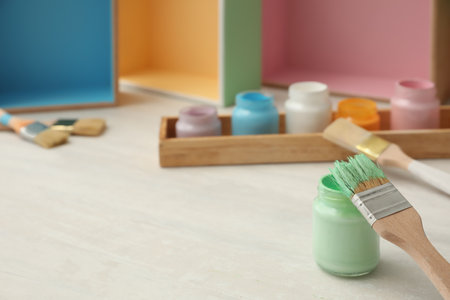Introduction: Creating Happy Spaces for Kids
Designing a child’s room is a special journey for many Indian families, as it is about more than just aesthetics. The right paint colours and wallpapers play a crucial role in shaping a nurturing environment where children can grow, dream, and feel secure. In Indian homes, where family values and traditions are deeply cherished, the décor of a kid’s room becomes an expression of love and care. Colours and patterns influence not only the mood but also the well-being and creativity of children. Thoughtfully selected shades can inspire imagination, encourage calmness, or even support learning. Moreover, incorporating elements from Indian culture—like vibrant hues inspired by festivals or motifs reflecting local art—can help children feel connected to their roots while creating a joyful space tailored to their unique personalities. By choosing the best paints and wallpapers with these factors in mind, parents can create rooms that are both practical and meaningful for their little ones.
2. Kid-Friendly Paint Choices: Safe and Vibrant Options
When designing kids’ rooms in Indian homes, choosing the right paint is essential for both safety and aesthetics. Parents should look for non-toxic, low-VOC (volatile organic compounds) paints to ensure indoor air quality remains healthy for growing children. Additionally, with the varied climate across India—ranging from humid coastal regions to dry northern plains—it’s wise to select paints that can withstand local weather while staying vibrant and easy to maintain.
Non-Toxic and Easy-to-Clean Paints
Children are naturally curious and energetic, often leaving little fingerprints or marks on walls. Washable paints are a practical choice, making it easier for parents to keep the room clean without frequent repainting. When shopping, look for labels such as “eco-friendly,” “child-safe,” or “EN71 certified,” which indicate the paint is free from harmful chemicals.
| Paint Type | Features | Best For |
|---|---|---|
| Emulsion Paints | Low odour, easy to clean, moisture-resistant | All climates, especially humid regions |
| Distemper Paints | Affordable, traditional finish, breathable | Dry areas, budget-friendly projects |
| Acrylic Eggshell/Satin | Durable, stain-resistant, subtle sheen | High-traffic kids’ rooms and play areas |
Lively Colours: Traditional and Modern Preferences
The colour palette you choose can influence your child’s mood and creativity. In many Indian homes, traditional shades like soft yellows, sky blues, and leafy greens remain popular for their calming effect. However, modern trends are shifting towards bolder tones such as coral pinks, teal blues, or even accent walls featuring playful murals or geometric patterns.
Tips for Choosing Colours:
- Consider Regional Climate: Light pastel colours help keep rooms cool in hot regions; deeper hues may add warmth in cooler northern states.
- Cultural Relevance: Shades like turmeric yellow (haldi), peacock blue (mor-pankh), or earthy terracotta reflect Indian heritage while keeping the space lively.
- Mood Enhancers: Greens promote calmness; oranges inspire energy; blues encourage relaxation and focus.
- Mix & Match: Combine two or three complementary shades for an engaging yet harmonious look.
Your child’s room should be a cheerful sanctuary—safe, easy to maintain, and filled with colours that spark joy!

3. Wallpaper Wonders: Patterns, Themes, and Indian Inspiration
When it comes to transforming your childs room into a playful haven, wallpaper offers endless creative possibilities. In Indian homes, wallpapers featuring popular themes like wildlife, mythology, and vibrant motifs are especially loved by both parents and kids. Wildlife-themed wallpapers, such as peacocks, elephants, tigers, or colourful birds, celebrate Indias rich biodiversity and spark curiosity in young minds. For families who value tradition, mythology-inspired designs—from stories of Krishna’s adventures to depictions of Hanuman or Ganesha—bring a sense of cultural pride and storytelling into the room. These patterns not only beautify the space but also help children connect with their heritage in a fun and visual way.
Another favourite among Indian parents is the use of vibrant geometric or floral motifs. These patterns reflect the lively colours found in Indian festivals and crafts, making the space energetic and inviting. Modern wallpaper brands in India now offer easy-to-install, peel-and-stick options that are perfect for busy families. Choose washable and durable materials so your child’s creativity—whether it’s an accidental crayon doodle or sticky fingers—won’t leave a lasting mark.
By choosing wallpapers that align with Indian aesthetics and values, you can create a joyful environment that encourages learning and imagination while celebrating your family’s unique culture.
4. Blending Culture and Modernity: Incorporating Indian Elements
When designing a kid’s room in an Indian home, striking the right balance between our rich cultural heritage and modern design trends can create a space that feels both familiar and exciting for children. By thoughtfully mixing traditional Indian patterns and motifs with contemporary styles, you not only celebrate your roots but also give your child a creative environment that stimulates learning and imagination.
Why Combine Tradition with Modern Style?
Children grow up in a world where global influences are strong, but grounding them in their own culture is equally important. Integrating Indian elements into paint colours or wallpaper themes can help children connect with their heritage while still enjoying a fresh, updated look in their rooms.
Popular Indian Motifs and Modern Pairings
| Traditional Element | Modern Interpretation | How to Use |
|---|---|---|
| Mughal Patterns | Geometric wallpapers with subtle Mughal arches or jali-inspired designs | Create an accent wall behind the bed or study table |
| Warli Art | Monochrome Warli murals combined with pastel paint colours | Use as a border or feature wall; pair with minimalistic furniture |
| Block Prints (Jaipur) | Wallpaper with block print motifs in soft, modern colour palettes | Add to wardrobes or reading nooks for a touch of tradition |
| Kalamkari Themes | Nature-inspired Kalamkari prints mixed with abstract art | Frame sections as wall panels or use on closet doors |
| Madhubani Paintings | Simplified Madhubani designs in playful hues | Create DIY canvas art with your child for a personalised touch |
Tips for Seamless Integration:
- Colour Coordination: Choose base paint colours that complement the dominant shades in your chosen motif—think muted yellows, earthy reds, indigo blues, or leafy greens.
- Balance is Key: Limit traditional patterns to one or two walls so the room doesn’t feel overwhelming. Mix these with solid-coloured walls or modern graphic prints.
- Interactive Decor: Consider chalkboard paint sections framed by ethnic borders or magnetic wallpapers with Indian-inspired shapes for interactive play.
- Cultural Stories: Incorporate storytelling through painted murals or wallpaper depicting folk tales, animals from Panchatantra, or festivals like Diwali and Holi.
A Relatable and Joyful Space for Children
The combination of India’s timeless artistry and modern simplicity creates an environment where children feel connected to their roots while exploring new ideas. This thoughtful blend not only beautifies their space but also encourages curiosity about our vibrant traditions. With mindful selection of paints and wallpapers, you can craft a kids’ room that truly feels like home—warm, inspiring, and uniquely Indian.
5. Practical Tips: Durability, Maintenance, and Budget
When designing a kids’ room in an Indian home, it’s essential to select paints and wallpapers that can handle both the unpredictable Indian monsoon and the energy of playful children. Here are some practical suggestions to help you make smart choices for durability, easy maintenance, and budget-friendliness.
Choose Monsoon-Resistant Materials
India’s climate varies across regions, but most areas experience heavy rains during monsoons. Opt for moisture-resistant or water-repellent paints such as washable emulsions or acrylic-based wall paints. These types are less likely to peel or develop patches due to humidity. For wallpaper, vinyl-coated options work best—they’re more resistant to dampness and can be wiped clean if needed.
Focus on Durability for Playful Kids
Kids are naturally curious and active, which means walls can easily become canvases for scribbles or get scuffed during playtime. Choose high-quality washable paints with stain resistance—these let you wipe away marks without damaging the finish. For wallpaper, go for those labeled “scrubbable” or “washable,” ensuring they stay fresh even after frequent cleaning sessions.
Maintenance Made Simple
Low-maintenance options will save busy parents time and effort. Satin or semi-gloss paint finishes are ideal because they don’t trap dust and are easy to clean. If you’re using wallpaper, avoid intricate textures that collect dust or dirt; instead, stick to smooth surfaces that can be gently wiped down with a damp cloth.
Smart Solutions for Every Budget
Creating a beautiful kids’ room doesn’t have to be expensive. Consider painting just one accent wall in a bright shade or with fun patterns—this brings cheerfulness without requiring large amounts of specialty paint or wallpaper. For budget-friendly wallpapers, local markets in cities like Delhi or Mumbai offer stylish options at reasonable prices. You can also mix-and-match: use durable paint on most walls and add a small area of decorative wallpaper for interest.
By focusing on materials that withstand Indian weather and childhood adventures while staying mindful of your budget, you’ll create a vibrant space where your child feels safe, comfortable, and inspired every day.
6. Involving the Family: Making Decorating a Joyful Experience
When it comes to decorating kids’ rooms in Indian homes, involving the whole family can transform the process from a simple task into a memorable bonding experience. Children often have vibrant imaginations and unique preferences, so inviting them to participate in choosing paint colours and wallpaper patterns gives them a sense of ownership and pride in their personal space. Parents can guide little ones by narrowing down options to safe, non-toxic paints or culturally inspired wallpapers featuring motifs like elephants, peacocks, or traditional block prints—making sure these choices reflect both family values and the child’s interests.
Set aside time for a “colour selection day” where everyone shares their favourite shades or themes. This can be a wonderful opportunity to teach children about colour psychology—explaining why calm blues are good for study corners or why cheerful yellows can brighten up play areas. Encourage kids to create mood boards using magazine cut-outs or digital apps; this not only sparks creativity but also helps visualise how the final room might look.
Don’t forget to make the actual decorating process fun! Assign age-appropriate tasks: young children can help with taping borders or peeling wallpaper backing under supervision, while older kids might enjoy painting small sections of wall or arranging wall decals. Celebrate each milestone together with a family treat, such as homemade laddoos or a pizza night. Through these shared moments, you’re not just creating a beautiful room—you’re fostering teamwork, communication, and joyful memories that will last long after the paint has dried.


